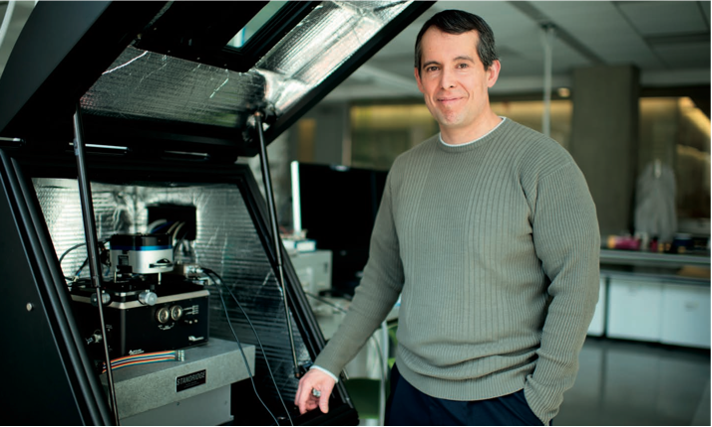Dr. Santiago Solares: An Engineer’s Friend

We all need friends, and who among us wouldn’t appreciate a friend who does the hard, unglamorous, behind-the-scenes work that allows us to shine? Dr. Santiago Solares is that friend. He does the behind-the-scenes materials and measurement science research that other engineers can rely on to build the nano-scale devices that amaze the rest of the world.
As a materials scientist, Dr. Solares is most concerned with being able to measure and describe for other engineers the properties of the materials they are going to use to build nano-scale systems. “If you want to build a safe bridge, you need to know the properties of steel and concrete,” says Dr. Solares. “So for small technologies, such as the design of a futuristic nano-machine, you also need to know those properties—how much you can push it, how much you can deform it, how much abuse it will take, or how it will change over time. But a lot of things are not yet measurable at that scale.”
And the challenges to being able to measure and describe these properties at the nano scale are significant. One of the challenges is the tools. According to Dr. Solares, the inadequacy of the tools—they simply cannot be made any smaller than they are—is a reason that many people tend to shy away from this research. “They’re the best available but they’re not as good as what we have at the larger scale, not even close,” he states. “It’s like changing a tire on your car with a wrench that is three times the size of your car.”
That presents another challenge: since the tools don’t allow the materials scientist to really see what he is doing, he always has to infer indirectly the behavior of the materials. And the behavior of the materials is what fascinates Dr. Solares.
Right now, he and his lab are using atomic force microscopy to study what happens to polymer solar cells in real life conditions. Polymer solar cells are cheap and easy to make, and they could be attractive to consumers because they are flexible and can be bent and twisted without cracking; but they can be deformed only up to a point and for a limited time. Eventually, all that bending and twisting can make them malfunction or stop working completely. Dr. Solares’ lab is trying to study from the nano-mechanical point of view to what point specifically the solar cells can be abused and still maintain their functionality or, alternatively, how to prevent their malfunction, knowing that they will be abused a bit.
Dr. Solares is no stranger to the real-life applications of his work. He spent seven years working in industry before turning to academic research, and he uses examples from industry to emphasize to his students the importance of learning well the limits of various materials and systems. “In the context of teaching, I can tell students exactly why they should learn this and I give them examples of serious things that happen when people don’t learn, because I have seen industrial accidents,” he says. “Not knowing your subject is dangerous.”

